Related Research Articles
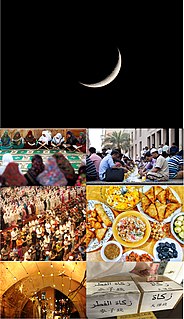
Ramadan is the ninth month of the Islamic calendar, observed by Muslims worldwide as a month of fasting (sawm), prayer, reflection and community. A commemoration of Muhammad's first revelation, the annual observance of Ramadan is regarded as one of the Five Pillars of Islam and lasts twenty-nine to thirty days, from one sighting of the crescent moon to the next.

Kolkata is the capital of the Indian state of West Bengal. Located on the eastern bank of the Hooghly River, the city is approximately 80 km (50 mi) west of the border with Bangladesh. It is the primary business, commercial, and financial hub of Eastern India and the main port of communication for North-East India. According to the 2011 Indian census, Kolkata is the seventh-most populous city in India, with a population of 45 lakh (4.5 million) residents within the city limits, and a population of over 1.41 crore (14.1 million) residents in the Kolkata Metropolitan Area. It is the third-most populous metropolitan area in India. In 2021, the Kolkata metropolitan area crossed 1.5 crore (15 million) registered voters. The Port of Kolkata is India's oldest operating port and its sole major riverine port. Kolkata is regarded as the cultural capital of India. Kolkata is the second largest Bengali-speaking city after Dhaka. It has the highest number of nobel laureates among all cities in India.
Calcutta Hawkers' Men Union is a trade union of hawkers in Kolkata. CHMU was founded in 1971. CHMU is affiliated to All India Trade Union Congress. Its membership is mainly based amongst food vendors.
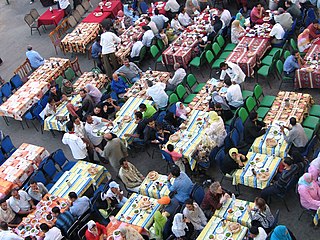
Iftar, also known as futoor, is the evening meal with which Muslims end their daily Ramadan fast at sunset. They break their fast at the time of the call to prayer (adhan) for the evening prayer. This is their second meal of the day; the daily fast during Ramadan begins immediately after the pre-dawn meal of suhur and continues during the daylight hours, ending with sunset with the evening meal of iftar.

The Indian Football Association, abbreviated as IFA, is the organisation that administers association football in the state of West Bengal, India. It is the oldest Football Association in India and was founded in 1893. Among the founders was former English international Elphinstone Jackson.
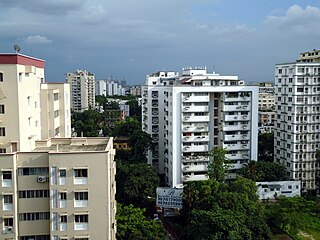
Ballygunge is a locality of South Kolkata, in Kolkata district, West Bengal, India.

The Bengal Renaissance, also known as the Bengali Renaissance, was a cultural, social, intellectual, and artistic movement that took place in the Bengal region of the British Raj, from the late 18th century to the early 20th century. Historians have traced the beginnings of the movement to the victory of the British East India Company at the 1757 Battle of Plassey, as well as the works of reformer Raja Rammohan Roy, considered the "Father of the Bengal Renaissance," born in 1772. Nitish Sengupta stated that the movement "can be said to have … ended with Rabindranath Tagore," Asia's first Nobel laureate.

Kolkata district is a district in the Indian state of West Bengal, headquartered in Kolkata.
Bangladeshi cuisine is the national cuisine of Bangladesh. Bangladeshi cuisine has been shaped by the diverse history and river-line geography of Bangladesh. The country has a tropical monsoon climate. The staple of Bangladesh is rice and fish. The majority of Bangladeshi people are ethnic Bengali, who follow Bengali cuisine, with a minority of non-Bengalis with their own unique cuisine. Bangladeshi food has more meat, especially beef, compared to West Bengal.
Kutchi Memons, also spelled as Cutchi Memons, are an ethnic group or caste from Kutch in Gujarat, India, who speak the Kutchi language. They are related to the Memons associated with the historic state of Kathiwar, a Muslim community of Pakistan and India, who speak the Memon language.

Kolkata, India, is largely inhabited by the ethnic community of the native Bengalis respectively. According to a report by the Indian Statistical Institute owned by the Government of India, the Kolkata city had a population of 4.5 million as of 2011 out of which the population of native Bengalis in Kolkata is almost 62% which comprised the majority of the city's population, whereas ethnic groups like Marwaris, Biharis and Urdu-speaking Muslims together forming 36% of the population which comes under the category of large minorities. Other Various micro-minority communities of Kolkata include as far as concerned follows -: Sindhi people, Pathan people, Marathi people, Odia people, Gujarati people, Kashmiri people, Punjabi people, Nepalis, Telugus, Tamil, Anglo-Indian, Iraqis, Jewish, Armenian, Tibetan, Greek, Parsi, Chinese, and Iraqi people etc.

Hare School is one of the oldest schools in Kolkata, India, teaching grades one to twelve under the West Bengal Board of Secondary Education and the West Bengal Council of Higher Secondary Education. It is a state government-administered boys school and was established by the Scottish watch-maker, David Hare. The establishment date is not agreed upon, but the official year of establishment is 1818. Thus the school is declared as the oldest western type school in Asia. The school is situated opposite the Presidency University, and is also adjacent to the University of Calcutta and Hindu School. The combined campuses of the Hare School and Presidency College is one of the largest in Kolkata.

Hindu School is a state government-administered school in Kolkata (Calcutta), India. Founded in 1817, it is the oldest modern educational institution in Asia. The institution played a key role during Bengal Renaissance period. It is located on College Street, in the vicinity of Hare School, College Square, Presidency University, Sanskrit College, Calcutta Medical College and the University of Calcutta.
Mosques in Kolkata refers to mosques in the city of Kolkata, in India.

Hawkers in Kolkata numbering 275,000 generated business worth ₹ 87.72 billion in 2005. In Kolkata, formerly known as Calcutta, in the Indian state of West Bengal, almost 80 per cent of the pavements are encroached by hawkers and illegal settlers. In many countries, hawkers use pavements or other public places to retail their goods or services but in Kolkata the magnitude has drawn special attention of administrators and law courts.

Mohammedan Sporting Club is an Indian multi-sports club based in Kolkata, West Bengal. Its football team competes in I-League, the second-tier of Indian football, as well as in Calcutta Football League (CFL), the oldest football league in Asia. Formed in February 1891, it is one of the oldest active football clubs in the country.
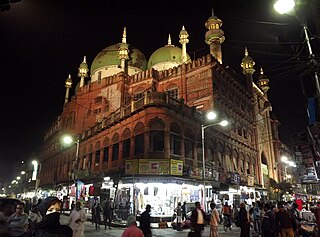
The Nakhoda Musjid is the principal mosque of Kolkata, India, in the Chitpur area of the Burrabazar business district in Central Kolkata, at the intersection of Zakaria Street and Rabindra Sarani.
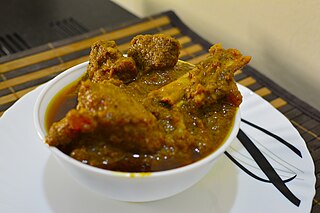
Mutton curry is a dish that is prepared from goat meat and vegetables. The dish is found in different variations across all states, countries and regions of South Asia and the Caribbean.
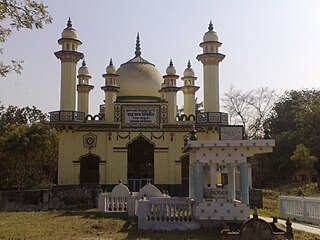
Moḥammad Abū Bakr Ṣiddīque al-Qurayshī was a Bengali Islamic scholar and the inaugural Pir of Furfura Sharif in West Bengal. He is regarded by his followers, who are scattered across eastern India and Bangladesh, as a mujaddid (reviver) of Islam in the region, due to his significant contributions in religious propagation via the establishment of mosques and madrasas, publication of newspapers and education development in neglected areas. He was the founding president of the sociopolitical Anjuman-i-Wazin-i-Bangla organisation, which advocated for causes such as the Khilafat Movement and Pakistan Movement. Siddique died in 1943, and his shrine is greatly venerated as one of West Bengal's most prominent Sufi centres.
Dukhiram Majumder was an Indian footballer, football manager, scout and club official, who is regarded as the first football coach in the country. He first understood the importance of Indian players wearing boots. During his coaching days, Majumder managed Calcutta Football League side Aryans Club, alongside nurturing talents like Gostha Pal, Shibdas Bhaduri, Syed Abdus Samad, Karuna Bhattacharya, and Balaidas Chatterjee.
References
- ↑ Mitra, Debraj (7 April 2022). "Ramazan mirrors friendly spirit of Kolkata in face of divisiveness". The Telegraph. Archived from the original on 26 June 2022. Retrieved 26 June 2022.
- ↑ "খাবারের গন্ধে ম-ম জাকারিয়া স্ট্রিট". The Indian Express (in Bengali). 29 May 2019. Archived from the original on 28 June 2022. Retrieved 26 June 2022.
- ↑ Mitra, Bishwabijoy (30 May 2019). "Zakaria Street is a heaven for food bloggers". The Times of India . Archived from the original on 26 June 2022. Retrieved 26 June 2022.
- ↑ Bhaumik, Neal (11 September 2019). "JUST PASSING THROUGH KOLKATA". Verge. Archived from the original on 27 June 2022. Retrieved 26 June 2022.
- ↑ Bandyopadhyay, Ritajyoti (2022). Streets in Motion: The Making of Infrastructure, Property, and Political Culture in Twentieth-century Calcutta. Cambridge University Press. doi:10.1017/9781009109208. ISBN 9781009109208. S2CID 250200020.
- ↑ Banka, Neha (30 March 2021). "Streetwise Kolkata: Beyond food and city's largest mosque, Zakaria Street is a story of Muslims and Marwaris". The Indian Express. Archived from the original on 26 June 2022. Retrieved 26 June 2022.
- ↑ Mitra, Bishwabijoy; Chakraborty, Shamaymita (14 May 2019). "Have the polls impacted the Ramzan mood on Zakaria Street?". Times of India. Archived from the original on 26 June 2022. Retrieved 26 June 2022.
- ↑ Saha, Somdatta (14 June 2022). "Food Trail: Explore Kolkata's Zakaria Street For The Most Indulgent Iftar Treat". NDTV. Archived from the original on 26 June 2022. Retrieved 26 June 2022.
- ↑ "Zakaria Street: Eating out in Kolkata". Times of India. 17 June 2015. Archived from the original on 26 June 2022. Retrieved 26 June 2022.
- ↑ Basu, Rriju (11 June 2017). "রমজানি স্বাদে জাকারিয়া যেন শহরের ফুড স্ট্রিট". Anandabazar Patrika (in Bengali). Archived from the original on 28 April 2020. Retrieved 26 June 2022.